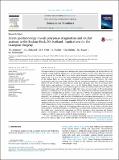Files in this item
Zircon geochronology reveals polyphase magmatism and crustal anatexis in the Buchan Block, NE Scotland : implications for the Grampian Orogeny
Item metadata
| dc.contributor.author | Johnson, T. E. | |
| dc.contributor.author | Kirkland, C. L. | |
| dc.contributor.author | Viete, D. R. | |
| dc.contributor.author | Fischer, S. | |
| dc.contributor.author | Reddy, S. M. | |
| dc.contributor.author | Evans, N. J. | |
| dc.contributor.author | McDonald, B. J. | |
| dc.date.accessioned | 2017-10-18T09:30:26Z | |
| dc.date.available | 2017-10-18T09:30:26Z | |
| dc.date.issued | 2017-11 | |
| dc.identifier | 249214743 | |
| dc.identifier | ee41a5c5-628c-40ed-98ef-857709d21fce | |
| dc.identifier | 85017407320 | |
| dc.identifier | 000413237600019 | |
| dc.identifier.citation | Johnson , T E , Kirkland , C L , Viete , D R , Fischer , S , Reddy , S M , Evans , N J & McDonald , B J 2017 , ' Zircon geochronology reveals polyphase magmatism and crustal anatexis in the Buchan Block, NE Scotland : implications for the Grampian Orogeny ' , Geoscience Frontiers , vol. 8 , no. 6 , pp. 1469-1478 . https://doi.org/10.1016/j.gsf.2017.02.002 | en |
| dc.identifier.issn | 1674-9871 | |
| dc.identifier.other | RIS: urn:F2C80F65E427E7EE239A38CD91DBBD83 | |
| dc.identifier.uri | https://hdl.handle.net/10023/11877 | |
| dc.description | We appreciate funding and support from the Research School of Earth Sciences, Australian National University for the SHRIMP analyses performed there. | en |
| dc.description.abstract | The type locality for high-temperature, low-pressure regional metamorphism, the Buchan Block in NE Scotland, exhibits profound differences to the rest of the Grampian Terrane. These differences have led some to regard the Buchan Block as an exotic crustal fragment comprising Precambrian basement gneisses and cover rocks thrust into their current position during Grampian orogenesis. Although rocks of the Buchan Block are now generally correlated with Dalradian strata elsewhere, the origin of the gneisses and the cause of the high heat flow and associated magmatism is debated. We report SIMS U–Pb and Hf isotopic data in zircon from high-grade rocks from the northeast (Inzie Head Gneiss) and northwest (Portsoy) corners of the Buchan Block. Around Inzie Head, upper amphibolite to granulite facies metasedimentary gneisses coexist with diorite sheets that were emplaced contemporaneously with partial melting of their host rocks, at least locally. U–Pb geochronology indicates a crystallization age for the diorite of 486 ± 9 Ma. Highly-deformed diorites within the Portsoy Gabbro have a crystallization age of 493 ± 8 Ma. Ages of ca. 490 Ma for magmatism and high-grade metamorphism, which are broadly contemporaneous with ophiolite obduction and the onset of orogenesis, are significantly older than the established peak of Grampian metamorphism (ca. 470 Ma).We propose a new model for the Grampian Orogeny involving punctuated tectonothermal activity due to tectonic switching during accretionary orogenesis. Rollback of a NW-dipping subduction zone at ca. 490 Ma produced a back-arc environment (the Buchan Block) with associated arc magmatism and high dT/dP metamorphism. Arrival of an outboard arc resulted in shortening (the initial phase of the Grampian Orogeny) at ca. 488 Ma. Initiation of a new, NW-dipping subduction zone to the SE of the ca. 488 Ma suture, which then began to rollback at ca. 473 Ma, led to lithospheric-scale extension, decompression melting and advective heating of the middle crust, producing the widespread ca. 470 Ma Grampian (classic Barrovian and Buchan) regional metamorphism. Resumed hinge advance and the final phase of shortening cut off the heat supply at ca. 465 Ma, marking the end of the Grampian Orogeny. | |
| dc.format.extent | 4139101 | |
| dc.language.iso | eng | |
| dc.relation.ispartof | Geoscience Frontiers | en |
| dc.subject | Dalradian | en |
| dc.subject | Grampian Orogeny | en |
| dc.subject | Buchan Block | en |
| dc.subject | Zircon geochronology | en |
| dc.subject | Magmatism | en |
| dc.subject | Metamorphism | en |
| dc.subject | GE Environmental Sciences | en |
| dc.subject | DAS | en |
| dc.subject.lcc | GE | en |
| dc.title | Zircon geochronology reveals polyphase magmatism and crustal anatexis in the Buchan Block, NE Scotland : implications for the Grampian Orogeny | en |
| dc.type | Journal article | en |
| dc.contributor.institution | University of St Andrews. School of Earth & Environmental Sciences | en |
| dc.identifier.doi | 10.1016/j.gsf.2017.02.002 | |
| dc.description.status | Peer reviewed | en |
| dc.identifier.url | http://www.sciencedirect.com/science/article/pii/S1674987117300312?via%3Dihub#appsec1 | en |
This item appears in the following Collection(s)
Items in the St Andrews Research Repository are protected by copyright, with all rights reserved, unless otherwise indicated.

